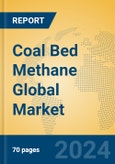Market Size and Growth Forecast
The global coal bed methane market is projected to reach between USD 12.0 billion and USD 16.0 billion in 2025, with a compound annual growth rate (CAGR) of 4% to 10% through 2030, reflecting the growing demand for natural gas and the development of unconventional gas resources.Regional Analysis
North America leads the market with established CBM production, particularly in the Powder River Basin and other significant coal-bearing regions. The region benefits from advanced extraction technologies and well-developed infrastructure. Australia shows strong growth driven by extensive CBM resources and increasing production capacity, particularly in Queensland. China demonstrates significant potential with vast coal reserves and growing energy demand, though production development faces technical and regulatory challenges. Europe maintains moderate activity focused on reducing greenhouse gas emissions from coal mining operations. India presents emerging opportunities with substantial coal reserves and increasing energy requirements.Application Analysis
- Residential: Expected steady growth driven by increasing household energy consumption and the shift toward cleaner burning fuels. CBM provides an efficient heating solution with lower emissions compared to traditional coal use. Market trends focus on distribution infrastructure development and consumer adoption of natural gas appliances.
- Commercial: Projected consistent expansion as businesses seek cost-effective and environmentally friendly energy solutions. Applications include heating, cooling, and process energy requirements across various commercial sectors. Development trends emphasize supply reliability and competitive pricing structures.
- Industrial: Anticipated robust growth due to industrial processes requiring clean-burning fuel sources. CBM serves as feedstock for chemical production, steel manufacturing, and other energy-intensive industries. Technological advances focus on improving gas quality and supply consistency.
- Power Generation: Expected significant expansion as utilities seek cleaner alternatives to coal-fired power plants. CBM offers reduced emissions and improved efficiency compared to conventional coal combustion. Trends emphasize grid stability and flexible generation capabilities.
- Transportation: Projected moderate growth with increasing adoption of compressed natural gas (CNG) and liquefied natural gas (LNG) vehicles. CBM provides a domestic fuel source for transportation applications. Development focuses on refueling infrastructure and vehicle technology advancement.
Key Market Players
Leading companies include PetroChina Company Limited, advancing CBM production in China; Arrow Energy, developing Australian CBM resources; BP, leveraging global expertise in unconventional gas; Essar, focusing on Indian CBM development; Baker Hughes, providing drilling and completion services; PETRONAS, expanding CBM operations in Malaysia; Reliance Industries Limited, developing Indian CBM assets; ConocoPhillips Company, utilizing unconventional gas expertise; G3 Exploration, specializing in CBM development; GEECL, focusing on Indian CBM projects; Halliburton, providing completion and production services; and Gazprom, exploring CBM opportunities in Russia. These companies drive market growth through technological innovation and resource development.Porter's Five Forces Analysis
- Threat of New Entrants: Moderate, as significant capital requirements and technical expertise create barriers, though attractive economics in some regions encourage new participants.
- Threat of Substitutes: Moderate to high, with conventional natural gas, renewable energy, and other fossil fuels serving as alternatives, though CBM offers unique advantages in certain applications.
- Bargaining Power of Buyers: Moderate, with end-users seeking competitive pricing and reliable supply, particularly in regions with multiple energy source options.
- Bargaining Power of Suppliers: Low to moderate, due to diverse CBM producers and competing energy sources, though transportation infrastructure can create regional supply constraints.
- Competitive Rivalry: Moderate to high, with companies competing on production costs, resource quality, and market access in a commodity-driven industry.
Market Opportunities and Challenges
Opportunities include the growing global demand for cleaner energy sources, with CBM offering lower emissions compared to coal combustion. Environmental regulations promoting methane capture from coal mining operations create additional market drivers. Technological advances in horizontal drilling and hydraulic fracturing improve CBM recovery rates. Emerging markets with significant coal reserves present untapped potential for CBM development.Challenges encompass the competitive landscape with conventional natural gas and renewable energy sources. Water production associated with CBM extraction creates environmental management requirements. Infrastructure development needs for gas gathering and transportation increase capital requirements. Regulatory uncertainties and environmental concerns in some regions may limit development opportunities. Technical challenges in some coal seam characteristics affect production economics.
This product will be delivered within 1-3 business days.
Table of Contents
Companies Mentioned
- PetroChina Company Limited
- Arrow Energy
- BP
- Essar
- Baker Hughes
- PETRONAS
- Reliance Industries Limited
- ConocoPhillips Company
- G3 Exploration
- GEECL
- Halliburton
- Gazprom








